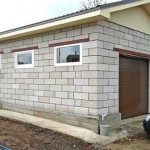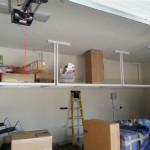```html
DIY Garage Shelves: Enhancing Efficiency and Organization
The garage, often relegated to a repository for tools, equipment, and miscellaneous items, can quickly descend into a state of disarray. This disorganization not only consumes valuable space but also hinders efficiency in completing tasks and locating necessary items. Implementing a well-designed shelving system is a fundamental step toward transforming a chaotic garage into a functional and organized workspace. Constructing DIY garage shelves offers a cost-effective and customizable solution to address specific storage needs and maximize available space.
Before embarking on the construction process, careful planning is crucial. A thorough assessment of current storage challenges, available space, and budget constraints will inform the design and material selection. Considerations should include the weight-bearing capacity required for the shelves, the dimensions of items to be stored, and the desired aesthetic appearance.
Planning and Design Considerations
Effective planning is the cornerstone of a successful DIY shelving project. The initial step involves a comprehensive evaluation of existing storage problems. Identifying the types of items that require storage, their dimensions, and their weight is critical for determining the necessary shelf size, spacing, and load-bearing capacity. For instance, storing heavy power tools necessitates more robust shelving than storing lightweight gardening supplies. Consider also the potential for future storage needs; designing a shelving system that accommodates growth will prevent premature obsolescence. Furthermore, a detailed measurement of the garage space is essential. This includes the overall dimensions of the garage, the location of windows and doors, and any obstructions that might impact shelf placement. Maximizing vertical space is often a key strategy in smaller garages. Finally, establishing a budget is critical for guiding material selection and design choices. Balancing cost-effectiveness with durability and aesthetic appeal will ensure a satisfactory outcome.
Once the planning phase is complete, the next step involves selecting appropriate materials. Wood is a common and versatile choice for DIY garage shelves, offering a balance of strength, affordability, and ease of construction. Common wood options include plywood, dimensional lumber (such as 2x4s), and medium-density fiberboard (MDF). Plywood offers good strength and stability, while dimensional lumber is well-suited for constructing the frame and support structure. MDF is a cost-effective option for shelving surfaces, but it is less resistant to moisture and heavy loads than plywood. Metal shelving systems are also available, offering superior strength and durability but typically at a higher cost. Metal shelves are often prefabricated, requiring less assembly than wooden shelves. Consider the environmental conditions of the garage when selecting materials. If the garage is prone to dampness or humidity, pressure-treated wood or metal is recommended to prevent rot or corrosion. Regardless of the material chosen, ensuring its quality and suitability for the intended purpose is paramount.
The design of the shelving unit should be tailored to the specific needs and constraints of the garage. Several design options are available, each with its own advantages and disadvantages. Freestanding shelves offer flexibility and portability, allowing for easy rearrangement. However, they may be less stable than wall-mounted shelves. Wall-mounted shelves maximize floor space and provide a clean, uncluttered look. However, they require secure attachment to the wall studs to ensure stability. Corner shelves are ideal for utilizing otherwise wasted space in corners. Adjustable shelves offer versatility, allowing for changes in shelf height to accommodate items of varying sizes. The design should also consider the aesthetic appearance of the shelving unit. Simple, clean lines are often preferred in a garage setting. Painting or staining the shelves can enhance their appearance and protect the wood from moisture and wear.
Essential Tools and Materials
Before commencing construction, gathering the necessary tools and materials is crucial. Having the right tools on hand will streamline the process and ensure accurate and safe construction. Essential tools include a measuring tape, a level, a pencil, a saw (circular saw or hand saw), a drill, a screwdriver, a stud finder, and safety glasses. A measuring tape is essential for accurately measuring the garage space and cutting materials to the correct dimensions. A level ensures that the shelves are installed horizontally, preventing items from sliding off. A pencil is used for marking cut lines and outlining the shelf design. A saw is necessary for cutting the wood or metal to the required lengths. A circular saw is more efficient for making straight cuts, while a hand saw is suitable for smaller projects or intricate cuts. A drill is used for pre-drilling holes for screws and for driving screws into the wood or metal. A screwdriver is used for tightening screws. A stud finder is essential for locating wall studs, which are necessary for securely attaching wall-mounted shelves. Finally, safety glasses are crucial for protecting the eyes from dust and debris during the construction process.
In addition to tools, a variety of materials are required for building the shelves. These materials will vary depending on the design and material selection. Common materials include wood (plywood, dimensional lumber, or MDF), screws, nails, wood glue, sandpaper, paint or stain, and brackets or supports. The amount of wood required will depend on the size and number of shelves. Screws provide a strong and durable connection between wood pieces. Nails can be used for lighter-duty applications. Wood glue enhances the strength of the joints and prevents them from loosening over time. Sandpaper is used for smoothing rough edges and preparing the wood for painting or staining. Paint or stain protects the wood from moisture and wear and enhances its aesthetic appearance. Brackets or supports are necessary for securely attaching the shelves to the wall or for providing additional support for heavy loads. Ensuring that all materials are of good quality and appropriate for the intended purpose is important for the longevity and stability of the shelving unit. Consider also the environmental impact of the materials chosen. Using sustainably sourced wood and low-VOC paints and stains will minimize the environmental footprint of the project.
The construction process involves several steps, including cutting the materials to size, assembling the frame, attaching the shelves, and finishing the surfaces. Begin by cutting the wood or metal to the required dimensions, using a measuring tape and saw. Accuracy is crucial to ensure that the shelves fit together properly. Assemble the frame by joining the wood pieces together using screws, nails, and wood glue. Ensure that the frame is square and level before proceeding. Attach the shelves to the frame, using screws or nails. For wall-mounted shelves, carefully locate the wall studs using a stud finder. Attach the shelves to the wall studs using screws, ensuring that they are securely fastened. Finally, sand the surfaces of the shelves to smooth any rough edges and prepare them for painting or staining. Apply paint or stain to protect the wood and enhance its aesthetic appearance. Allow the paint or stain to dry completely before placing items on the shelves.
Construction Techniques and Safety Measures
Adhering to safe construction practices is paramount throughout the DIY shelving project. Prioritizing safety minimizes the risk of accidents and injuries. Always wear safety glasses to protect the eyes from dust and debris. Use a dust mask to avoid inhaling sawdust. When using power tools, follow the manufacturer's instructions carefully and wear appropriate safety gear, such as ear protection. Work in a well-ventilated area to avoid inhaling fumes from paints and stains. Be mindful of the placement of electrical cords and avoid working near water or other potential hazards. When lifting heavy objects, use proper lifting techniques to avoid back strain. If working at heights, use a sturdy ladder and ensure that it is properly secured. Never rush the construction process; take your time and work carefully to ensure that all steps are completed correctly. Finally, if you are unsure about any aspect of the construction process, consult with a qualified professional.
Accurate measurements are crucial for ensuring that the shelves fit together properly and that the shelving unit is level and square. Use a high-quality measuring tape and double-check all measurements before cutting any materials. When cutting wood or metal, use a saw that is appropriate for the material and ensure that the blade is sharp. Cut along the marked lines carefully and avoid splintering the wood. When assembling the frame, use a square to ensure that the corners are at right angles. Use a level to ensure that the frame is level and plumb. When attaching the shelves, use screws or nails that are long enough to penetrate the wood securely, but not so long that they protrude through the other side. Pre-drilling holes for screws will prevent the wood from splitting.
Securing wall-mounted shelves to the wall studs is essential for ensuring their stability and weight-bearing capacity. Use a stud finder to locate the wall studs. Mark the location of the studs on the wall. Drill pilot holes through the wall studs at the marked locations. Attach the shelves to the wall studs using screws that are long enough to penetrate the studs deeply. Use washers to distribute the weight of the shelves evenly across the studs. For added security, consider using heavy-duty brackets or supports. If the wall studs are not located in the optimal positions for the shelves, consider using drywall anchors to provide additional support. However, drywall anchors are not as strong as wall studs and should only be used for lighter loads.
Once the shelves are constructed and installed, consider implementing a system for organizing and labeling the stored items. Store items that are frequently used in easily accessible locations. Store heavier items on lower shelves to prevent them from falling and causing injury. Use clear plastic bins or containers to store smaller items and keep them organized. Label the bins or containers clearly so that you can easily identify their contents. Group similar items together to make them easier to find. Regularly declutter the shelves and remove any items that are no longer needed. By implementing a well-organized storage system, you can maximize the efficiency and functionality of your garage.
```
How To Build Shelving In A Garage Three Ways Ana White

20 Thrifty Diy Garage Organization Projects The House Of Wood

Super Efficient 2x4 Garage Shelves Diy Storage

25 Completely Brilliant Garage Storage Ideas Abby Organizes

25 Completely Brilliant Garage Storage Ideas Abby Organizes

How To Build Shelving In A Garage Three Ways Ana White

25 Completely Brilliant Garage Storage Ideas Abby Organizes

How To Build Shelving In A Garage Three Ways Ana White

How To Diy The Best Overhead Garage Storage South House Designs

25 Completely Brilliant Garage Storage Ideas Abby Organizes
Related Posts








